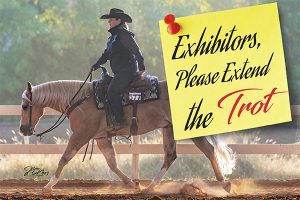Exhibitors, Please Extend The Trot
Click here to read the complete article
282 – May/June, 2024
More and more often, exhibitors at all levels are hearing the announcer call for an extended gait in their riding classes–most often that’s an extended trot or an extended jog. That extended trot looks different in different disciplines, whether it’s Hunter Under Saddle or a Western performance class like Ranch or Horsemanship. But nailing the extended trot, no matter the class, is more than going faster–and it takes preparation. Horses need to stay in frame, show a distinct difference between their extended gait and a slower jog or trot, and their backs should not be hollow, all of which are feats easier said than done. On the following pages, trainers and judges offer their perspective of what an extended jog or trot should look like, as well as some ideas about how to make it happen in the pen.
Extending the Trot in Hunter Under Saddle
A beautiful extended trot in Hunter Under Saddle is easy to imagine. The horse is free in his movement, level across the top, and has a long, even stride where hind footfalls land in the hoofprints of the front footfalls. There is something floaty and easy about the horse’s gait that makes it hard to look away.
According to the AQHA rulebook, a horse showing an average extended trot in Hunter Under Saddle is one that “moves up in his pace and still appears smooth to post on.” This is differentiated from a good extended trot, which is a horse who has “an obvious lengthening in his stride with a slight increase in his pace making him more versatile. This horse is still smooth but appears to have more length with less effort being exerted.” A horse classified as poor in this gait is one that “never appears to lengthen his stride but just trots faster. He may also appear to be jarring and rough to ride.”
Trainer Alyse Roberts finds a special niche in Hunter Under Saddle horses. She describes a great trotter as a horse that has “big sweepy movement from their shoulders. I love when they’re matching diagonals and when their front and hind legs are in sync with a nice level topline and great expression. They cover ground with an obviously lengthened stride.” She compares that to an average trotter who may be “quicker legged, have a shorter stride and choppier feel instead of that long, slow post of the great trotters.”
Click here to read the complete article
282 – May/June, 2024











